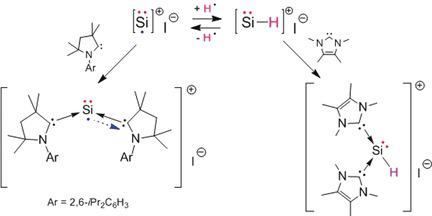当前位置:
X-MOL 学术
›
Angew. Chem. Int. Ed.
›
论文详情
Our official English website, www.x-mol.net, welcomes your feedback! (Note: you will need to create a separate account there.)
Trapping a Silicon(I) Radical with Carbenes: A Cationic cAAC–Silicon(I) Radical and an NHC–Parent‐Silyliumylidene Cation
Angewandte Chemie International Edition ( IF 16.6 ) Pub Date : 2017-05-24 , DOI: 10.1002/anie.201702760 Yan Li 1 , Yuk-Chi Chan 1 , Bi-Xiang Leong 1 , Yongxin Li 1 , Emma Richards 2 , Indu Purushothaman 3 , Susmita De 3 , Pattiyil Parameswaran 3 , Cheuk-Wai So 1
Angewandte Chemie International Edition ( IF 16.6 ) Pub Date : 2017-05-24 , DOI: 10.1002/anie.201702760 Yan Li 1 , Yuk-Chi Chan 1 , Bi-Xiang Leong 1 , Yongxin Li 1 , Emma Richards 2 , Indu Purushothaman 3 , Susmita De 3 , Pattiyil Parameswaran 3 , Cheuk-Wai So 1
Affiliation

|
The trapping of a silicon(I) radical with N‐heterocyclic carbenes is described. The reaction of the cyclic (alkyl)(amino) carbene [cAACMe] (cAACMe=:C(CMe2)2(CH2)NAr, Ar=2,6‐iPr2C6H3) with H2SiI2 in a 3:1 molar ratio in DME afforded a mixture of the separated ion pair [(cAACMe)2Si:.]+I− (1), which features a cationic cAAC–silicon(I) radical, and [cAACMe−H]+I−. In addition, the reaction of the NHC–iodosilicon(I) dimer [IAr(I)Si:]2 (IAr=:C{N(Ar)CH}2) with 4 equiv of IMe (:C{N(Me)CMe}2), which proceeded through the formation of a silicon(I) radical intermediate, afforded [(IMe)2SiH]+I− (2) comprising the first NHC–parent‐silyliumylidene cation. Its further reaction with fluorobenzene afforded the CAr−H bond activation product [1‐F‐2‐IMe‐C6H4]+I− (3). The isolation of 2 and 3 confirmed the reaction mechanism for the formation of 1. Compounds 1–3 were analyzed by EPR and NMR spectroscopy, DFT calculations, and X‐ray crystallography.
中文翻译:

用卡宾捕获硅(I)自由基:阳离子cAAC-硅(I)自由基和NHC-母体-亚甲硅烷基阳离子
描述了用N-杂环卡宾捕获硅(I)自由基的方法。环状(烷基)(氨基)卡宾[cAAC Me ](cAAC Me =:C(CMe 2)2(CH 2)NAr,Ar = 2.6,i Pr 2 C 6 H 3)与H 2的反应在DME中摩尔比为3:1的SiI 2提供了分离的离子对[(cAAC Me)2 Si:的混合物。] +我- (1),其特点是阳离子CAAC -硅(I)基团,和[CAAC我-H] +我-。此外,NHC-碘硅(I)二聚体[I Ar(I)Si:] 2(I Ar =:C {N(Ar)CH} 2)与4当量的I Me(:C {N (Me)的CME} 2),其通过硅(I)基团的中间体,得到[(I形成进行我)2的SiH] +我- (2包括第一NHC-父- silyliumylidene阳离子)。它与氟苯的进一步反应得到C Ar -H键活化产物[1-F-2-I Me - C 6 H 4 ] + I−(3)。2和3的分离证实了形成1的反应机理。化合物1 - 3通过EPR和NMR光谱,DFT计算,和X-射线晶体学分析。
更新日期:2017-05-24
中文翻译:

用卡宾捕获硅(I)自由基:阳离子cAAC-硅(I)自由基和NHC-母体-亚甲硅烷基阳离子
描述了用N-杂环卡宾捕获硅(I)自由基的方法。环状(烷基)(氨基)卡宾[cAAC Me ](cAAC Me =:C(CMe 2)2(CH 2)NAr,Ar = 2.6,i Pr 2 C 6 H 3)与H 2的反应在DME中摩尔比为3:1的SiI 2提供了分离的离子对[(cAAC Me)2 Si:的混合物。] +我- (1),其特点是阳离子CAAC -硅(I)基团,和[CAAC我-H] +我-。此外,NHC-碘硅(I)二聚体[I Ar(I)Si:] 2(I Ar =:C {N(Ar)CH} 2)与4当量的I Me(:C {N (Me)的CME} 2),其通过硅(I)基团的中间体,得到[(I形成进行我)2的SiH] +我- (2包括第一NHC-父- silyliumylidene阳离子)。它与氟苯的进一步反应得到C Ar -H键活化产物[1-F-2-I Me - C 6 H 4 ] + I−(3)。2和3的分离证实了形成1的反应机理。化合物1 - 3通过EPR和NMR光谱,DFT计算,和X-射线晶体学分析。


























 京公网安备 11010802027423号
京公网安备 11010802027423号